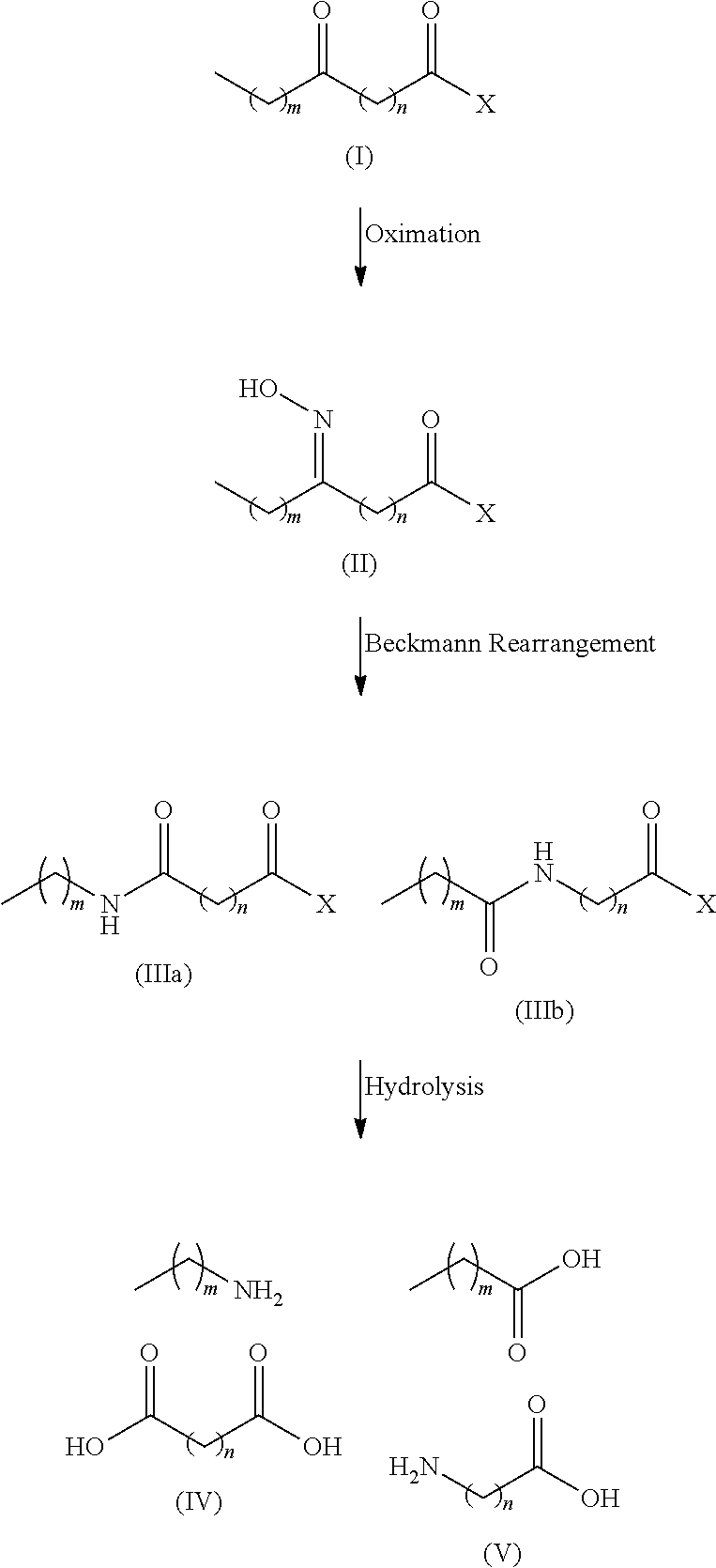Process for the co-production of long chain amino acids and dibasic acids
a technology of dibasic acid and amino acid, which is applied in the preparation of oximes, carboxylic acid amide preparations, organic chemistry, etc., can solve the problems of inherently dangerous and difficult control, and requires a very corrosive alkaline scission of castor oil
- Summary
- Abstract
- Description
- Claims
- Application Information
AI Technical Summary
Benefits of technology
Problems solved by technology
Method used
Image
Examples
example 1
tion of Nylon-11 Monomer and Dodecanedioic Acid
[0057]94 g of methyl 12-ketostearate was dissolved in 500 mL of toluene, followed by an aqueous solution of hydroxylamine sulfate (about 8%) containing 13.5 g of hydroxylamine. The mixture was vigorously stirred at 70-85° C., while the pH of the solution was adjusted to 4.5 to 5.0 with aqueous ammonia. After reacting for 6 hours, the starting material was completed transformed to methyl 12-oxime stearate as indicated by HPLC analysis.
[0058]After oximation reaction was complete, the mixture was settled to separate off aqueous phase and the organic phase was dried. To the toluene solution were added 1.1 g of cyanuric chloride and 1.5 g of zinc chloride. The solution was stirred for 2 hours at 90-105° C. to complete the Beckmann rearrangement. The reaction was terminated by adding 50 mL of water. The product of mixed amide derivative of an off-white color was obtained after separating aqueous phase and recovering toluene.
[0059]The mixed am...
example 2
tion of Nylon-9 Monomer and Sebacic Acid
[0062]94 g of methyl 10-ketostearate was dissolved in 500 mL of butyl acetate, followed by an aqueous solution of hydroxylamine sulfate (about 8%) containing 12.5 g of hydroxylamine. The mixture was vigorously stirred for 6 hours at 70-80° C., while the pH of the solution was adjusted to 4.5 to 5.0 with aqueous ammonia. HPLC analysis indicated that the starting material was completely transformed to methyl 10-oxime stearate.
[0063]After aqueous phase was separated off, 50 mL of butyl acetate was distilled to remove water. The butyl acetate solution was added 0.8 g of triphosgene and 1.2 g of zinc chloride, stirred at 90° C. for 3 hours to complete the Beckmann rearrangement, which was terminated by adding 50 mL of water. The product of mixed amide derivative of an off-white color was obtained after separating aqueous phase and recovering butyl acetate.
[0064]The solid material of mixed amide derivatives were dissolved in 200 mL of acetic acid, f...
example 3
tion of Nylon-13 Monomer and Brassylic Acid
[0066]102.2 g of 14-ketoarachidic acid methyl ester was dissolved in 500 mL of anisole, followed by an aqueous solution of hydroxylamine sulfate (about 8%) containing 16.5 g of hydroxylamine. The mixture was vigorously stirred for 8 hours at 75-85° C., while the pH of the solution is adjusted to 4.5 to 5.0 with aqueous ammonia. HPLC analysis indicated that the starting material was completely transformed to methyl ester of 14-oxime arachidic acid.
[0067]After aqueous phase was separated off, 50 mL of anisole was distilled to remove water azeotropically. The anisole solution was added 1.2 g of p-toluenesulfonylchloride and 1.5 g of zinc chloride, stirred at 90-105° C. for 2 hours to complete the Beckmann rearrangement, which was terminated by adding 50 mL of water. The product of mixed amide derivatives of an off-white color was obtained after separating aqueous phase and recovering anisole.
[0068]The solid material was dissolved in 700 mL of ...
PUM
| Property | Measurement | Unit |
|---|---|---|
| Temperature | aaaaa | aaaaa |
| Temperature | aaaaa | aaaaa |
Abstract
Description
Claims
Application Information
 Login to View More
Login to View More - R&D
- Intellectual Property
- Life Sciences
- Materials
- Tech Scout
- Unparalleled Data Quality
- Higher Quality Content
- 60% Fewer Hallucinations
Browse by: Latest US Patents, China's latest patents, Technical Efficacy Thesaurus, Application Domain, Technology Topic, Popular Technical Reports.
© 2025 PatSnap. All rights reserved.Legal|Privacy policy|Modern Slavery Act Transparency Statement|Sitemap|About US| Contact US: help@patsnap.com



